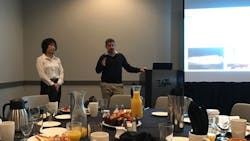Building Energy Standard 90.1 Talk on Menu of ASHRAE Press Breakfast
Major changes in the recently published 2016 version of ANSI/ASHRAE/IES 90.1, Energy Standard for Buildings Except Low-Rise Residential Buildings, was the subject of the 2017 ASHRAE Press Breakfast, held this morning at the Las Vegas Convention Center as part of the 2017 International Air-Conditioning, Heating, Refrigerating Exposition (AHR Expo).
Bing Liu, a former member of the 90.1 committee who is group manager responsible for Pacific Northwest National Laboratory’s (PNNL's) Building Energy Regulatory Analysis Group and a program manager overseeing the Building Energy Codes Program in support of the U.S. Department of Energy, provided an overview of the changes:
- 121 addenda.
- Major format changes for each use.
- New climate maps aligning with ANSI/ASHRAE Standard 169-2013, Climatic Data for Building Design Standards.
- A new performance-based compliance path.
- Significant whole-building energy changes.
Michael Rosenberg, a member of the 90.1 committee and the chief senior research scientist for PNNL, detailed major changes related to:
- Envelope—fenestration, walls and doors, building air leakage.
- Mechanical—increased equipment-efficiency requirements, replacement equipment needing to meet many requirements formerly for new equipment only, automatic reduction of HVAC when hotel/motel guestrooms are unoccupied, chilled-water-plant metering, economizer fault detection and diagnostics.
- Lighting—reduced lighting-power allowances for exterior, interior, and retail display lighting; the requirement that exterior and parking-garage lighting be reduced by 50 percent during non-business hours; shorter light poles for parking areas; regulation of dwelling-unit lighting.
- Power—automatic shutoff control for 50 percent of receptacles.
Rosenberg also discussed the new performance-based compliance path, Appendix G, which he said is similar to, but more flexible than, the Energy Cost Budget method.
About the Author
Scott Arnold
Executive Editor
Described by a colleague as "a cyborg ... requir(ing) virtually no sleep, no time off, and bland nourishment that can be consumed while at his desk" who was sent "back from the future not to terminate anyone, but with the prime directive 'to edit dry technical copy' in order to save the world at a later date," Scott Arnold joined the editorial staff of HPAC Engineering in 1999. Prior to that, he worked as an editor for daily newspapers and a specialty-publications company. He has a bachelor's degree in journalism from Kent State University.

